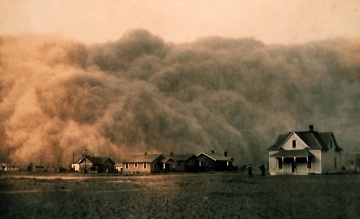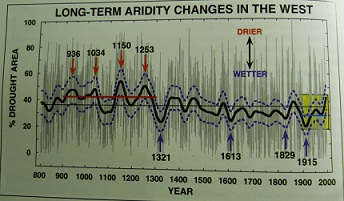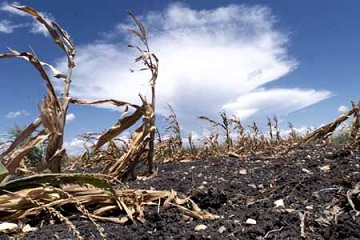| Friday, 2025-11-21, 6:29 AM | Main | Registration | Login |
|
Statistics
Total online: 1 Guests: 1 Users: 0 |
Abrupt Change in Land Hydrology
ABRUPT
CHANGES IN THE EARTH’S CLIMATE SYSTEM
ABRUPT CHANGE IN LAND HYDROLOGY
Much of the research on the climate response to increased
GHG concentrations, and most of the public’s understanding of that work, has
been concerned with global warming. Accompanying
this projected globally uniform increase in temperature, however, are spatially
heterogeneous changes in water exchange between atmosphere and the Earth’s
surface that are expected to vary much like the current daily mean values of
precipitation and evaporation (IPCC, 2007).
Although projected spatial patterns of hydroclimate change are complex,
these projections suggest that many already wet areas are likely to get wetter
and already dry areas are likely to get drier, while some intermediate regions
on the poleward flanks of the current subtropical dry zones are likely to
become increasingly arid.
These anticipated changes will increase problems at both
extremes of the water cycle, stressing water supplies in many arid
and semi-arid regions while worsening flood hazards and erosion in many wet
areas. Moreover, the instrumental, historical, and prehistorical record of
hydrological variations indicates that transitions between extremes can occur
rapidly relative to the time span under consideration. Over the course of several decades, for
example, transitions between wet conditions and dry conditions may occur within
a year and can persist for several years.
Abrupt changes or shifts in climate that lead to drought
have had major impacts on societies in the past. Paleoclimatic data document
rapid shifts to dry conditions that coincided with downfall of advanced and
complex societies. The history of the
rise and fall of several empires and societies in the Middle East between 7000
and 2000 B.C. have been linked to abrupt shifts to
persistent drought conditions (Weiss and Bradley, 2001). Severe drought leading to crop failure and
famine in the mid-8th century has been suggested as cause for the
decline and collapse of the Tang Dynasty (Yancheva et al., 2007) and the
Classic Maya (Hodell et al.,1995). A
more recent example of the impact of severe and persistent drought on society
is the 1930s Dust Bowl in the Central United States (Fig. 1.4), which led to a
large-scale migration of farmers from the Great Plains to the Western
United States. Societies in
many parts of the world today may now be more insulated to the impacts of
abrupt climate shifts in the form of drought through managed water resources
and reservoir systems. Nevertheless,
population growth and over-allocation of scarce water supplies in a number of
regions have made societies even more vulnerable to the impacts of abrupt
climate change involving drought.

Figure 1.4. Photograph showing a dust storm approaching Stratford, Texax, during
the 1930s Dust Bowl. (NOAA Photo Library, Historic NWS collection).
Variations in water supply, in general, and protracted
droughts, in particular, are among the greatest natural hazards facing the United States
and the globe today and in the foreseeable future. According to the national Climatic Data
Center, National Oceanic and Atmospheric Administration (NCDC, NOAA), over the
period from 1980 to 2006 droughts and heat waves were the second most expensive
natural disaster in the United States behind tropical storms. The annual cost of drought to the United States
is estimated to be in the billions of dollars.
Although there is much uncertainty in these figures, it is clear that
drought leads to (1) crop losses, which result in a loss of farm income and an
increase in Federal disaster relief funds and food prices, (2) disruption of
recreation and tourism, (3) increased fire risk and loss of life and property,
(4) reduced hydroelectric energy generation, and (5) enforced water
conservation to preserve essential municipal water supplies and aquatic
ecosystems (Changnon et al., 2000;
Pielke and Landsea, 1998; Ross
and Lott, 2003).
History of North
American Drought
In Chapter 3 of this report, we examine North American
drought and its courses from the perspective of the historical record and,
based on paleoclimate records, the last 1,000 years and the last 10,000
years. This longer temporal perspective
relative to the historical record allows us to evaluate the natural range of
drought variability under a diverse range of mean climatic conditions,
including those similar to the present.
Instrumental precipitation and temperature data and
tree-ring analyses provide sufficient information to identify six serious
multiyear droughts in western North America
since 1856. Of these, the most famous is
the "Dust Bowl” drought that included most of the 1930s decade (Fig. 1.4). The
other two in the 20th century are the severe drought in the
Southwest from the late 1940s to the late 1950s and the drought that began in
1998 and is ongoing. Three droughts in the middle to late 19th
century occurred (with approximate dates) from 1856 to 1865, from 1870 to 1876,
and from 1890 to 1896.
Is the 1930s Dust Bowl drought the worst that can
conceivably occur over North America? The instrumental and historical data only go
back about 130 years with an acceptable degree of spatial completeness over the
United States,
which does not provide us with enough time to characterize the full range of
hydroclimatic variability that has happened in the past and could conceivably
happen in the future independent of any added effects due to greenhouse
warming. To do so, we must look beyond
the historical data to longer natural archives of past climate information to gain
a better understanding of the past occurrence of drought and its natural range
of variability.
Much of what we have learned about the history of North
American drought over the past 1,000 years is based on annual ring-width patterns
of long-lived trees that are used to reconstruct summer drought based on the
Palmer Drought Severity Index (PDSI).
This information and other paleoclimate data have identified a period of
elevated aridity during the "Medieval climate anomaly” (MCA) period (A.D. 900-1300) that included four
particularly severe multidecadal megadroughts (Fig. 1.5) (Cook et al., 2004). The range of annual drought variability
during this period was not any larger than that seen after 1470, suggesting
that the climate conditions responsible for these early droughts each year were
apparently no more extreme than those conditions responsible for droughts
during more recent times. This can be
appreciated by noting that only 1 year of drought during the MCA was marginally
more severe than the 1934 Dust Bowl year.
This suggests that the 1934 event may be used as a worst-case scenario
for how severe a given year of drought can get over the West. What sets these MCA megadroughts apart from
droughts of more modern times, however, is their duration, with droughts during
the MCA lasting much longer than historic droughts in the Western
United States.

Figure 1.5. Percent area affected by drought (PDSI<–1)
in the area defined as
the West (see Chapter 3 of this
report) (from Cook et al., 2004). Annual data
are in gray and a 60-year low-pass filtered version is indicated by the thick
smooth curve. Dashed
blue lines are 2-tailed 95% confidence limits based on
bootstrap resampling. The modern (mostly
20th century) era is highlighted in
yellow for comparison to an increase in aridity prior to about A.D. 1300.
The emphasis up to now has been on the semiarid to arid Western United States because that is where the late-20th
century drought began and has largely persisted up to the present time. Yet,
previous studies indicate that megadroughts have also occurred in the important
crop-producing states in the Midwest and Great Plains
as well (Stahle et al., 2007). In particular, a tree-ring PDSI
reconstruction for the Great Plains shows the
MCA period with even more persistent drought than the Southwest, but now on a
centennial time scale.
Examination of drought history over the last 11,500
years (referred to as the Holocene Epoch) is motivated by
noting that the projected changes in both the radiative forcing and the
resulting
climate of the 21st century far exceed those registered
by either the instrumental records of the past century or by geologic
archives that can be calibrated to derive climate
(proxy records) of the past few millennia. In other words, all of the variations in
climate over the instrumental period and over the past millennia
reviewed above have occurred in a climate system whose controls have not
differed much from those of the 20th century.
Consequently, a longer term perspective is required to describe
the behavior of the climate system under controls
as different from those at present as those of the
21st century will be, and to assess the potential
for abrupt climate changes to occur in response to gradual changes in
large-scale forcing.
It is important to emphasize that the controls of
climate during the 21st century and during the Holocene
differ from one another, and from those of the 20th century,
in important ways. The
major difference in controls of climate between the early
20th, late 20th and 21st century is in
atmospheric composition (with an additional component of land-cover
change). In contrast, the major
difference between the controls in the 20th and 21st
centuries and those in the early to middle Holocene is in the latitudinal and
seasonal distribution of solar radiation.
Accordingly, climatic variations during the Holocene should not be
thought of either as analogs for future climates or as examples of what might
be observable under present-day climate forcing if records were longer, but
instead should be thought of as the result of a natural experiment within the
climate system that features large perturbations of the controls of
climate.
The paleoclimatic record from North
America indicates that drier conditions than
present commenced
in the mid-continent between 10 and 8 thousand years ago (ka) (Webb et
al., 1993),
and ended after 4 ka. The variety of paleoenvironmental indicators reflect
the spatial extent and timing of these moisture
variations, and in general suggest that the dry
conditions increased in their intensity during the interval from
11 ka to 8 ka, and then gave way to increased moisture after 4
ka. During the middle of this interval
(around 6 ka) dry conditions were widespread.
Lake-status indicators at 6ka indicate lower-than-present levels (and
hence drier-than-present conditions) across most of the continent, and
quantitative interpretation of pollen data shows a similar patter of overall
aridity, but again with some regional and local variability, such as
moister-than-present conditions in the Southwestern United States (Williams et
al., 2004). Although the region of
drier-than-present conditions extends into the Northeastern United States and
eastern Canada, most of the
evidence for mid-Holocene dryness is focused on the mid-continent, in
particular the Great Plains and Midwest, where
the evidence for aridity is particularly clear.

Causes of North
American Drought
Empirical studies and climate model experiments show
that droughts over North America and globally are significantly
influenced by the state of tropical sea surface
temperatures (SSTs), with cool, persistent La Niña-like
SSTs in the eastern equatorial Pacific frequently
causing development
of droughts over the Southwestern United States and Northern Mexico.
Climate models
that have evaluated this linkage need only prescribe small changes in SSTs,
no more than
a fraction of a degree Celsius, to result in reductions in
precipitation. It is the persistence of the SST anomalies and associated
moisture deficits that creates serious drought conditions. In the Pacific, the SST anomalies presumable
arise naturally from dynamics similar to those associated with the El Niño
Southern Oscillation (ENSO) on time scales of a year to a decade (Newman et
al., 2003). On long time scales, the
dynamics that link tropical Pacific SST anomalies to North American
hydroclimate appear as analogs of higher frequency phenomena associated with
ENSO (Shin et al., 2006). In general,
the atmospheric response to La Niña-like conditions forces descent of air over
western North America that suppresses
precipitation. In addition to the ocean
influence, some modeling and observational estimates indicate that
soil-moisture feedbacks also influence precipitation variability.
The causes of the MCA megadroughts appear to have similar
origin to the causes of modern droughts, which is consistent with the similar
spatial patterns, expressed MCA and modern droughts (Herweijer et al.,
2007). In particular, modeling
experiments indicate that these megadroughts may have occurred in response to
cold tropical Pacific SSTs and warm subtropical North Atlantic SSTs externally
forced by high irradiance and weak volcanic activity (Mann et al., 2005;
Emile-Geay et al., 2007). However, this
result is tentative, and the exceptional duration of the droughts has not been
adequately explained, nor whether they also involved forcing from SST changes
in other ocean basins.
Over longer time spans, the paleoclimatic record indicates
that even larger hydrological changes have taken place in response
to past changes
in the controls of climate that rival in magnitude those
predicted for the next several decades and centuries. These changes
were driven
ultimately by variations in the Earth’s orbit that altered
the seasonal and latitudinal distribution of incoming solar
radiation. The climate boundary conditions
associated with those changes were quite different from those of the past
millennium and today, but they show the additional range of natural variability
and truly abrupt hydroclimatic change that can be expressed by the climate
system.
SUMMARY
The paleoclimatic record reveals dramatic changes in North
American hydroclimate over the last millennium that was not
associated with changes in greenhouse gases and human- induced global
warming. Accordingly, one important implication of these results
is that because
these megadroughts occurred under conditions not too unlike today’s,
the United States still has the capacity to enter into a prolonged state of
dryness even in the absence of increased greenhouse-gas forcing.
In response to increased concentration of GHGs,
the semi-arid regions of the Southwest are projected to dry in the 21st
century, with the model results suggesting, if they
are correct, that the transition may already be
underway (Seager et al., 2007). The
drying in the Southwest is a matter of great concern because
water resources
in this region are already stretched, new development of resources will be
extremely difficult, and the population (and thus demand for water)
continues to grow rapidly. Other
subtropical regions of the world are also expected to dry in the near future,
turning this feature of global hydroclimatic change into an international issue
with potential impacts of migration and social stability. The midcontinental U.S. Great
Plains could also experience changes in water supply impacting
agricultural practices, grain exports, and biofuel production.
There
is no clear evidence to date of human-induced global climate change on North
American precipitation amounts. However, since the IPCC AR4 report, further
analysis of climate model scenarios of future hydroclimatic change over North America and the global subtropics indicates that
subtropical aridity is likely to intensify and persist due to future greenhouse
warming. This projected drying extends poleward into the United States
Southwest, potentially increasing the likelihood of severe and persistent
drought there in the future. If the model results are correct, then this drying
may have already begun, but currently cannot be definitively identified amidst
the considerable natural variability of hydroclimate in Southwestern
North America.
NOTE: The term "forcing”
is used throughout this report to indicate any mechanism that causes the
climate system to change, or respond. Examples of forcings discussed in this
report include freshwater forcing of ocean circulation and changes in
sea-surface temperatures and radiative forcing as a forcing of drought. As
defined by the IPCC Third Assessment Report (Church et al., 2001), radiative forcing refers to a change in the net radiation at
the top of the troposphere caused by a change in the solar radiation, the
infrared radiation, or other changes that affect the radiation energy absorbed
by the surface (e.g.,
changes in surface
reflection properties), resulting in a radiation imbalance. A positive
radiative forcing tends to warm the surface on average, whereas a negative
radiative forcing tends to cool it. Changes in GHG concentrations represent a
radiative forcing through their absorption and emission of infrared radiation.
|
 |  |





